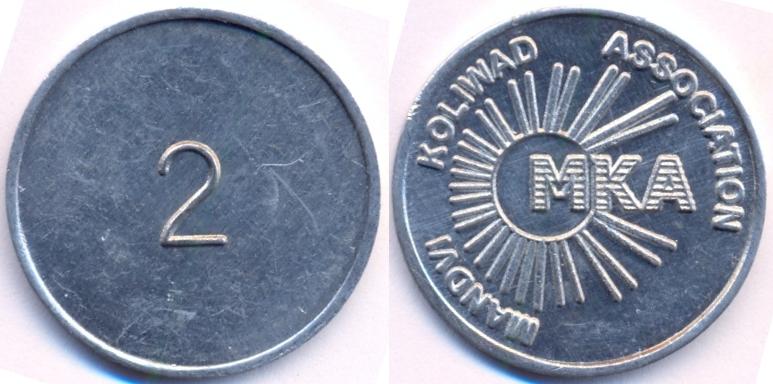|
 |
 |
|
Mandvi-Koliwad
Association |
| |
|
Anyone travelling by bus in India's major cities is affected by the shortage
of small change. Bus conductors often ask for change, and if you don't have
any, often doesn't return any. They just ignore giving back a rupee or
two, but some don't protest if they get a rupee or two less. Then give a
conductor Rs 10, for the minimum bus fare of Rs 7, and he may return you Rs
5 or may ignore giving you back anything unless you ask for change. Small
shops may give a toffee you don't need. The number of coins issued is
limited, since it costs the Central Bank (CB) more than the face value to
mint coins, and CB encourages consumers to return coins into circulation
rather than accumulate at home. In India however, customers insist on
correct change and unable to get sufficient coins from the banks, traders
have to pay a heavy premium to get the coins. |
|
Here is a recent telling sample: The wholesale traders in South Mumbai, were
facing perennial shortage of 1, 2 and 5 Rupee coins. "For one (Indian) rupee
coins worth Rs 100 one has to pay Rs 114, while for two rupee coins worth Rs
100 one has to pay Rs 115. For five rupee coins worth Rs 100 one has to pay
Rs 118. These rates keep changing. During festivals, the premium goes as
high as Rs 125 for coins worth Rs100," according to a Mumbai trader. |
| The
Think Tank of their association (Mandvi-Koliwad Association), reeling
under official coin shortages and black-marketing of the small change, pondered over the problem and came up with a brilliant
solution. So brilliant that we ordinary mortals would be dazzled to
blindness by it. Believe me or not, the solution was “minting the coins” on
their own. Fed up with the coin shortage, the traders in the south Mumbai
wholesale markets of Masjid Bunder and Bhendi Bazaar have hit upon an idea to use their own
tokens which are honoured within their community, virtually like official
currency. They put about 50 thousands of Re1 and Rs 2 denominations of these
coins into circulation in the first week of January 2012. At the moment they assure us that
the circulation is within their own empire. All these details have appeared
in the News Paper. (DNA of the 23rd January 2012, front page). The denomination
is printed on the obverse and on the reverse the MKA's logo is boldly
minted. A customer need not legally accept a token as much as (s)he may not
accept a toffee, since the shop has no change. The trading community was
left with no option "since over a year, the coin shortage is plaguing the
markets. The coins, made by the Mandvi-Koliwad association, were put in
circulation in the first week of January. “A metal cast was made for one
rupee and two rupee coins. Coins worth Rs50,000 have been made in the first
batch; more will be made depending on the response,” said Dinesh Shah, a
grocery store owner and member of the association. These coins are minted
and are being distributed in the wholesale markets in Bhendi Bazaar and
Masjid Bunder. |
| |
|
 |
| 2 Rupees. Year:
ND (2012). Weight:
2.57g. Metal:
Aluminum.
Diameter:
32 mm. Edge:
Plain. Alignment:
Medal. Mint:
N/A. Obverse:
"2" written in the center. Reverse:
"MANDVI KOLIWAD ASSOCIATION" written around their logo.
Mintage:
N/A.
Minted Years: One year
type. |
|
| |
| “We
had no other option. For the past one year, shortage of coins has troubled
us. Earlier, coins were easily available through the Reserve Bank of India
outlet, but that too has stopped now.” Rampant black-marketing, because of
the shortage, is another troubling aspect. “The situation is so bad that we
have to pay a heavy premium on the coins,” said Abdul Sattar, a bakery
owner. "Right now, only regular traders are using the coins so that the
circulation remains within the market," said another trader.
Perturbed by reports of
illegally-minted small denomination coins being used in certain parts of the
city, the Reserve Bank of India (RBI) promised to get to the bottom of the
case. "I have gone through the reports. These are newspaper reports
indicating its use in some areas. We have to verify it. I have asked the
RBI's Mumbai office to get details of it," RBI Governor Duvvuri Subbarao
(in office: 05 Sep 2008 - 04 Sep 2013) told reporters. RBI Deputy General
Manager Vaibhav Chaturvedi said that so far, nearly 12
billion coins have been put into circulation in the markets. "There is no
shortage at any levels of any kind and we have sufficient stocks in our
currency chests also," Mr Chaturvedi assured, though he wondered where
the coins were going, referring to the complaints of shortages. Since it
probably costs RBI more than face value to mint their coins, wouldn't the
RBI be saved, if the markets issue their own tokens accepted by the public
as coins. |
|
|
|
|
| |
|
|
| |
|
Micro-Nations |
| |
|
Chiefa Coins |
|
|


